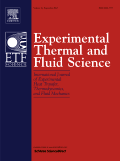
EXPERIMENTAL THERMAL AND FLUID SCIENCE
Scope & Guideline
Shaping the landscape of applied sciences through experimental knowledge.
Introduction
Aims and Scopes
- Thermal Transport Phenomena:
Research on heat transfer mechanisms, including conduction, convection, and radiation in various systems, particularly in complex environments or under extreme conditions. - Fluid Dynamics and Flow Behavior:
Investigation of fluid flow characteristics, including turbulence, two-phase flow, and flow patterns in micro and macro scales, with an emphasis on experimental validation. - Combustion and Energy Conversion:
Studies related to combustion processes, including flame dynamics, emission characteristics, and energy conversion efficiencies, often involving alternative fuels and advanced combustion technologies. - Advanced Measurement Techniques:
Development and application of novel experimental methodologies, such as laser diagnostics, particle image velocimetry (PIV), and thermography, for measuring flow and thermal fields. - Micro and Nano-scale Thermal and Fluid Systems:
Research focusing on thermal and fluid phenomena at micro and nano scales, including applications in energy systems, microreactors, and biomedical devices. - Environmental and Industrial Applications:
Exploration of thermal and fluid systems in industrial processes, environmental contexts, and energy systems, aiming to solve practical engineering challenges.
Trending and Emerging
- Advanced Nanofluids and Hybrid Systems:
Research on nanofluids and hybrid cooling systems is on the rise, emphasizing enhanced thermal properties and efficiency in heat transfer applications. - Microfluidics and Microchannel Studies:
There is a growing interest in microfluidic systems and their applications in energy, biomedicine, and chemical processing, highlighting the need for precise control of fluid behavior at small scales. - Sustainable Energy and Alternative Fuels:
Investigation of sustainable energy solutions and the use of alternative fuels in combustion processes are trending, driven by global energy challenges and environmental concerns. - Thermal Management in Electronics:
Research focusing on thermal management solutions for electronic devices, including advanced cooling technologies and materials, is increasingly prominent due to the rise of high-performance electronics. - Data-Driven and AI-Assisted Research:
The integration of machine learning and data-driven approaches in experimental thermal and fluid science is emerging, allowing for more efficient analysis and prediction of complex phenomena.
Declining or Waning
- Conventional Heat Exchanger Studies:
Research specifically focused on traditional heat exchangers has seen a decline, as the field shifts towards more innovative and hybrid systems that incorporate advanced materials and techniques. - Single-phase Fluid Flow Studies:
Investigations centered around single-phase flow dynamics are becoming less common, as there is a growing interest in more complex multi-phase and turbulent flow phenomena. - Low Reynolds Number Flow Studies:
Research focusing on low Reynolds number flows is diminishing, likely due to a shift towards studies that address high Reynolds number flows and their applications in real-world scenarios. - Basic Thermodynamics:
Papers focusing solely on fundamental thermodynamic principles without experimental validation or application are less frequently published, reflecting a trend towards applied research. - Static Heat Transfer Studies:
The focus on static heat transfer investigations is waning as the field moves towards dynamic and transient heat transfer phenomena that are more applicable to modern engineering challenges.
Similar Journals

Computational Thermal Sciences
Illuminating the Future of Thermal SciencesComputational Thermal Sciences, an esteemed journal published by BEGELL HOUSE INC, presents cutting-edge research at the intersection of computational mathematics, energy engineering, and fluid dynamics. With an ISSN of 1940-2503 and an E-ISSN of 1940-2554, this journal aims to disseminate high-quality research articles, reviews, and methodologies that improve our understanding of thermal processes and their applications. Renowned for its solid impact in the field, it holds a Q3 ranking in multiple categories including Computational Mathematics and Energy Engineering for 2023. As the field evolves, the journal continues to play a pivotal role in bridging theoretical research with practical innovations, thereby catering to a diverse audience of researchers, professionals, and students. Although it operates on a subscription model, the journal ensures accessibility to significant contributions in thermal sciences from 2009 to 2024, fostering an environment of knowledge sharing and collaboration.
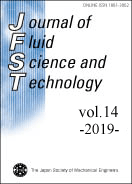
Journal of Fluid Science and Technology
Pioneering Research in Fluid Science and TechnologyThe Journal of Fluid Science and Technology, published by the Japan Society of Mechanical Engineers, serves as a pivotal platform for the dissemination of cutting-edge research in the fields of fluid mechanics and mechanical engineering. With an ISSN of 1880-5558, this Open Access journal has been dedicated to advancing the understanding of fluid flow and transfer processes since its establishment. As of 2023, it holds a significant position with a Q3 quartile ranking in both Fluid Flow and Transfer Processes and Mechanical Engineering categories. Researchers and practitioners are encouraged to explore the journal’s extensive collection of articles, contributing to the body of knowledge that impacts various practical applications in engineering and technology. The journal, which has established a reputation for quality amidst a competitive landscape, further fosters international collaboration and education by providing unrestricted access to its content. For professionals and students alike, the Journal of Fluid Science and Technology represents an invaluable resource for the latest findings and innovations in fluid dynamics and mechanical systems.
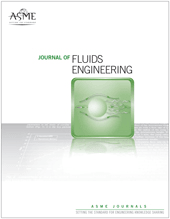
JOURNAL OF FLUIDS ENGINEERING-TRANSACTIONS OF THE ASME
Elevating Standards in Fluids Engineering ScholarshipJOURNAL OF FLUIDS ENGINEERING-TRANSACTIONS OF THE ASME, published by the renowned American Society of Mechanical Engineers (ASME), stands as a pivotal platform for disseminating cutting-edge research in the field of mechanical engineering, specifically focusing on fluid mechanics and its diverse applications. With an established history dating back to 1897, this journal features research that pushes the boundaries of knowledge and technology in areas such as fluid dynamics, thermal engineering, and hydrodynamics. Although it is not an open-access journal, it maintains rigorous peer-review standards, ensuring the publication of high-quality scholarly articles that contribute to the academic and professional community. In the latest rankings, it holds a respectable position within the Q2 category of mechanical engineering journals, reflecting its significant impact, as evidenced by its Scopus rank of #204 out of 672, placing it in the 69th percentile. Researchers, professionals, and students alike will find this journal to be a vital resource for the latest developments and innovative insights in fluids engineering.

JOURNAL OF ENGINEERING PHYSICS AND THERMOPHYSICS
Bridging Physics and Engineering for a Sustainable FutureJOURNAL OF ENGINEERING PHYSICS AND THERMOPHYSICS, published by Springer, is a vital resource for researchers and professionals in the fields of engineering physics and thermophysics. With an ISSN of 1062-0125 and an E-ISSN of 1573-871X, this esteemed journal has been disseminating high-quality research since its inception, covering critical advancements in both condensed matter physics and various engineering disciplines. Despite its classification within the third quartile in both Scopus categories for 2023, the journal remains a significant conduit for innovative studies that push the boundaries of knowledge in thermal and physical engineering, with converged years spanning from 1992 to 1997 and 2004 to 2024. The journal does not offer open access, which means subscribers and institutions have exclusive access to its rich content. As the field continues to evolve, JOURNAL OF ENGINEERING PHYSICS AND THERMOPHYSICS plays an essential role in fostering scholarly discussions and supporting the academic community in tackling contemporary engineering challenges.

EXPERIMENTS IN FLUIDS
Elevating knowledge in fluid mechanics with impactful research.EXPERIMENTS IN FLUIDS is a prestigious journal in the field of fluid mechanics, published by SPRINGER, renowned for its rigorous peer-reviewed research and experimental studies that advance the understanding of fluid behavior in various contexts. With an ISSN number of 0723-4864 and an E-ISSN of 1432-1114, this journal has published influential works since its inception in 1983, maintaining a convergence of data and insights crucial for both academia and industry. Its impressive impact factor and ranking in the Q1 category for Computational Mechanics, Fluid Flow and Transfer Processes, Mechanics of Materials, and Physics and Astronomy underscore its significance in fostering high-quality research in these domains. Researchers and professionals benefit from the comprehensive access to experimental methodologies, innovative applications, and cutting-edge results that the journal provides without the Open Access model. The journal's offices located in New York, USA, facilitate its global outreach, making it an essential resource for scholars and practitioners seeking to deepen their expertise in fluid dynamics and related fields.

INTERNATIONAL JOURNAL OF HEAT AND FLUID FLOW
Advancing the Frontiers of Heat and Fluid DynamicsFounded in 1979, the INTERNATIONAL JOURNAL OF HEAT AND FLUID FLOW is a premier publication in the fields of mechanical engineering, fluid dynamics, and heat transfer, published by Elsevier Science Inc. With an impressive impact factor and ranking in the Q1 category for Mechanical Engineering and Q2 for Condensed Matter Physics and Fluid Flow and Transfer Processes, this journal is highly regarded for its rigorous peer-reviewed articles that contribute significantly to the advancement of knowledge in these critical areas. Researchers, professionals, and students can access cutting-edge studies that explore the intricacies of thermal and fluid systems, ensuring they stay at the forefront of scientific exploration. The Scopus rankings further affirm its role as a leading source of impactful research, with significant placements in crucial academic categories. Join an active community of scholars committed to innovation and excellence in the exploration of heat and fluid flow phenomena.
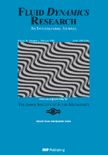
FLUID DYNAMICS RESEARCH
Connecting Theoretical and Experimental Studies in Fluid MechanicsFLUID DYNAMICS RESEARCH, published by IOP Publishing Ltd, is a pivotal journal dedicated to advancing the understanding of fluid dynamics through interdisciplinary research that spans several domains including mechanical engineering and physics. With an ISSN of 0169-5983 and E-ISSN 1873-7005, this journal provides a vital platform for researchers aiming to disseminate new findings and theoretical advancements in fluid flow and transfer processes. As of 2023, FLUID DYNAMICS RESEARCH holds a commendable position within the academic community, ranked Q3 in fluid flow and transfer processes, mechanical engineering, and miscellaneous physics and astronomy categories. The journal showcases a diverse array of articles that not only inspire collaboration among professionals and students but also ensure that theoretical and experimental studies are accessible for further development in the field. Operating from the United Kingdom, the journal offers a unique opportunity for scholars worldwide to contribute to the vibrant community dedicated to understanding the complexities of fluid dynamics, even as it anticipates converging its years of research from 1986 to 2024.

JOURNAL OF ENHANCED HEAT TRANSFER
Transforming Heat Transfer Knowledge into Practical ApplicationsThe JOURNAL OF ENHANCED HEAT TRANSFER, published by BEGELL HOUSE INC, is a prominent resource for researchers and professionals in the fields of mechanical engineering, fluid flow and transfer processes, and condensed matter physics. With a history spanning from 1993 to 2024, this journal offers a platform for disseminating cutting-edge research and innovations that enhance our understanding of heat transfer phenomena. Although it operates under a traditional subscription model, its impressive standing is underscored by its Scopus rankings—positioned within the 59th percentile for Mechanical Engineering and 58th percentile for Fluid Flow and Transfer Processes. Additionally, it holds Q2 and Q3 categorizations in relevant fields, reflecting its importance in advancing knowledge and applications in heat transfer technology. This journal effectively bridges the gap between theoretical insights and practical solutions, making it an indispensable tool for academics, industrial practitioners, and students eager to explore advancements in thermal management and efficiency.
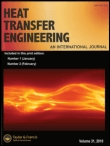
HEAT TRANSFER ENGINEERING
Driving the evolution of thermal management and engineering.HEAT TRANSFER ENGINEERING is a leading international journal published by Taylor & Francis Inc, dedicated to advancing the field of heat transfer and thermal engineering. With a strong focus on the key aspects of Condensed Matter Physics, Fluid Flow and Transfer Processes, and Mechanical Engineering, this journal covers a comprehensive range of topics from experimental studies to theoretical analysis, aiming to foster innovative research and practical applications. Since its inception in 1979 and continuing through 2024, the journal has established itself as an essential resource for researchers and industry professionals alike, reflected in its solid rankings within Scopus—holding a Q2 quartile classification in multiple engineering disciplines. Although not open access, the journal ensures broad accessibility through institutional subscriptions, making cutting-edge research readily available. With its rigorous peer-review process and commitment to quality, HEAT TRANSFER ENGINEERING plays a crucial role in shaping the future of thermal management solutions and engineering practices.
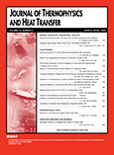
JOURNAL OF THERMOPHYSICS AND HEAT TRANSFER
Unlocking the Secrets of Thermal DynamicsJOURNAL OF THERMOPHYSICS AND HEAT TRANSFER, published by the American Institute of Aeronautics and Astronautics, serves as a vital platform for the dissemination of cutting-edge research in the fields of thermophysics and heat transfer. With an ISSN of 0887-8722 and an E-ISSN of 1533-6808, this journal has been pivotal in enhancing our understanding of heat transfer mechanisms since its inception in 1987, continuing through 2024. It occupies a noteworthy position in various academic categories, boasting Q2 rankings in both Fluid Flow and Transfer Processes and Mechanical Engineering, reflecting its significant contribution to the engineering and physical sciences community. Although it currently does not offer Open Access options, the journal’s repository of rigorous peer-reviewed articles remains accessible to researchers, professionals, and students eager to expand their knowledge and apply innovative findings in aerospace, condensed matter physics, and planetary sciences. Emphasizing both theoretical and experimental approaches, the JOURNAL OF THERMOPHYSICS AND HEAT TRANSFER remains an indispensable resource for advancing the frontiers of engineering and applied sciences.